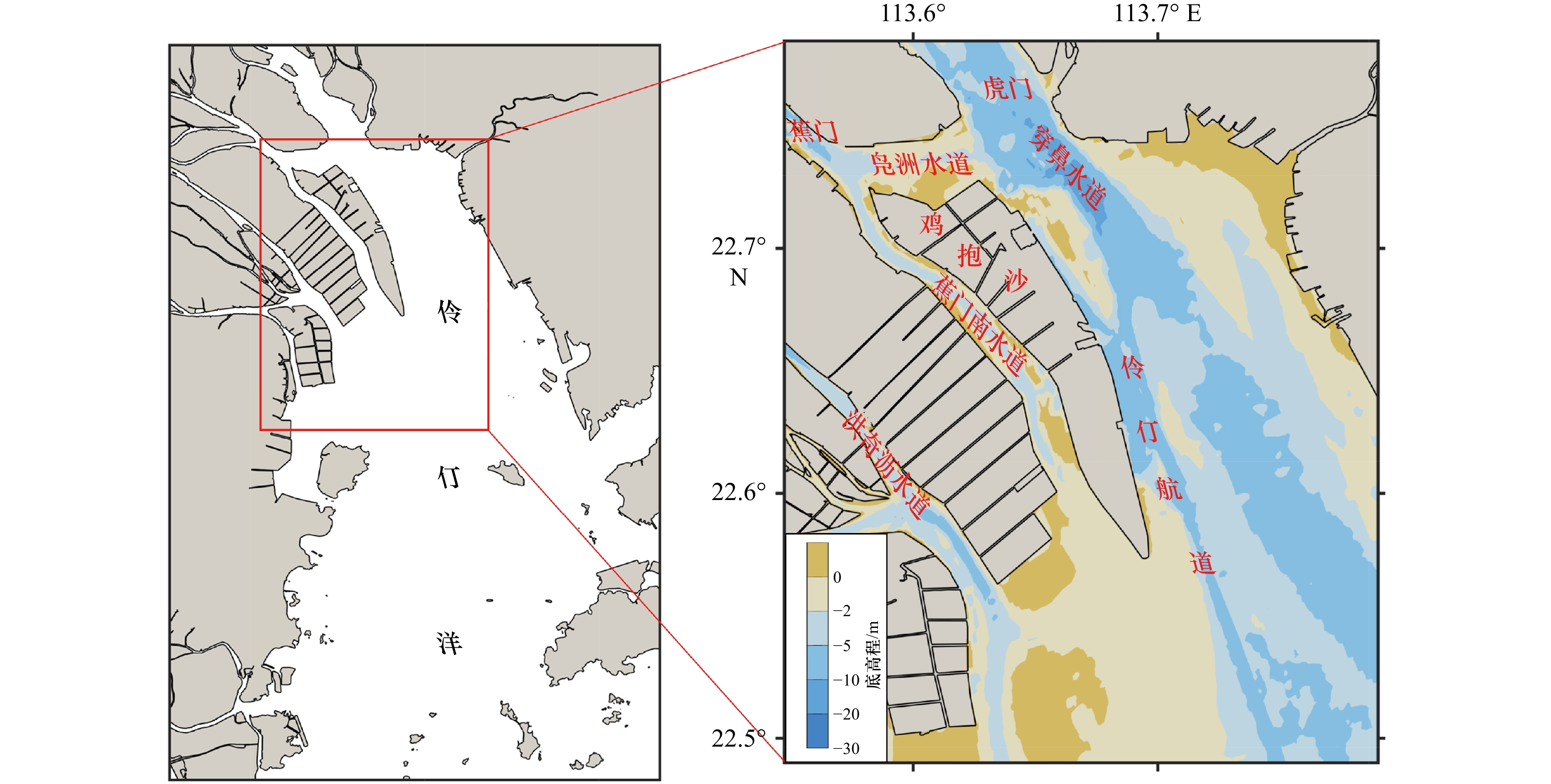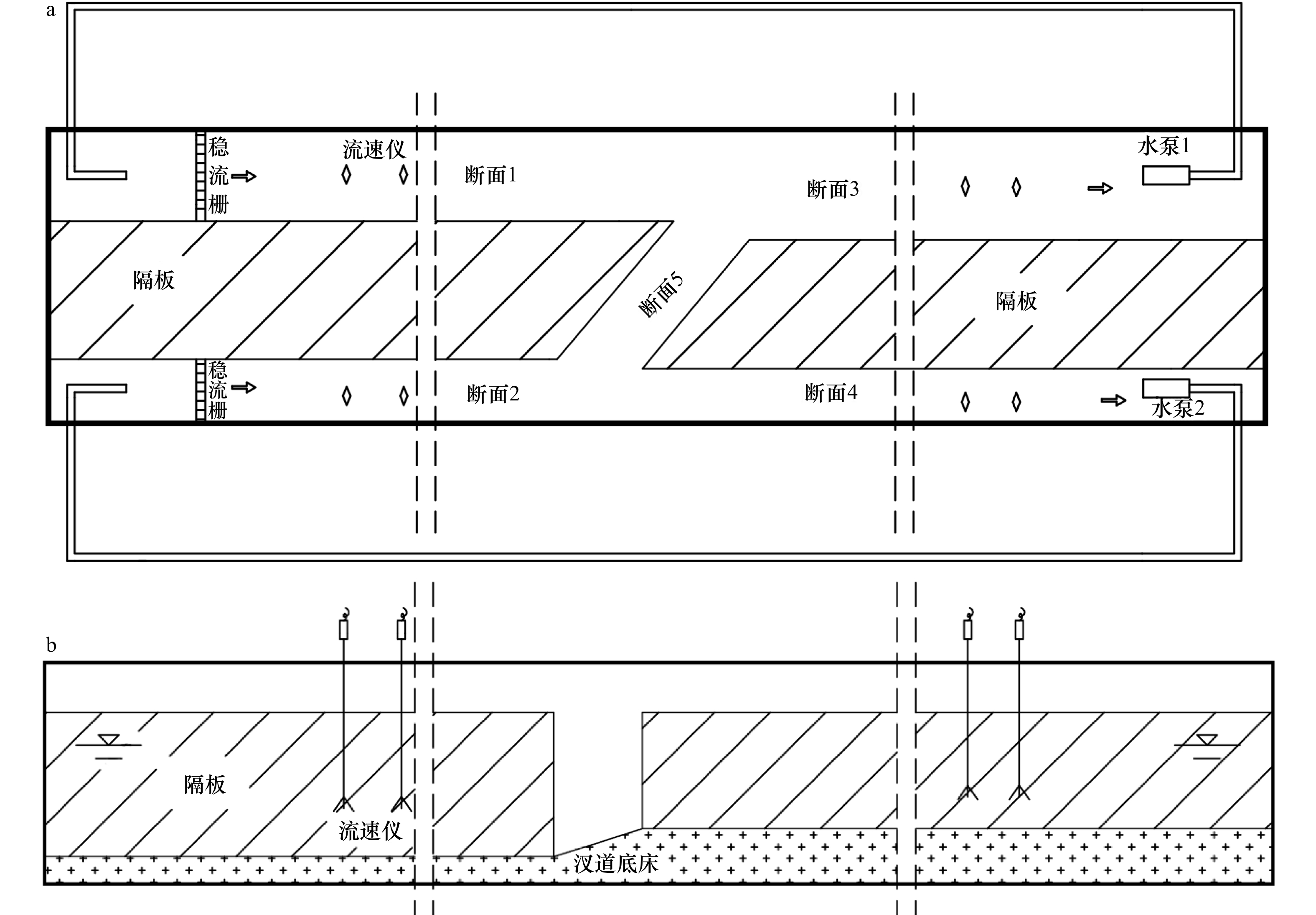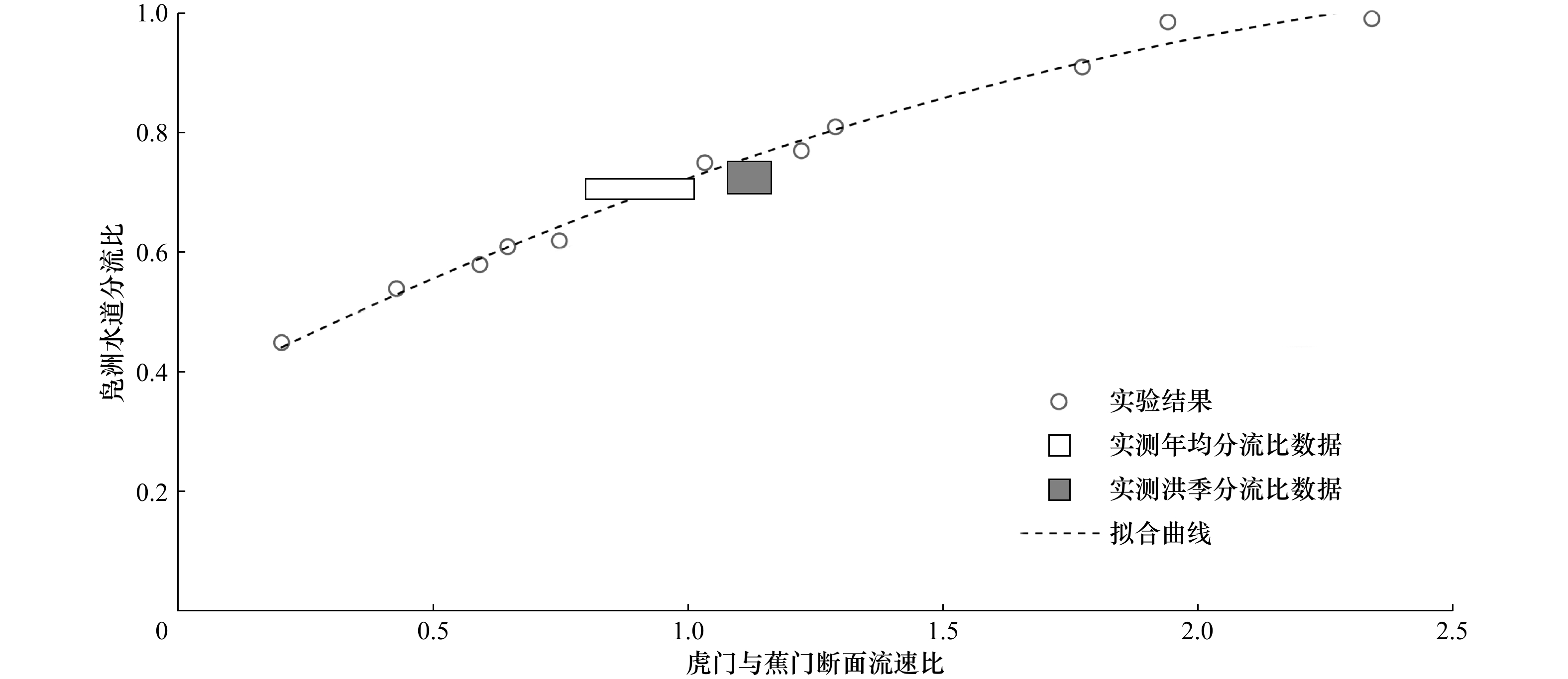Flume experiment on flow division ratio of bifurcated Jiaomen outlet in the Zhujiang River
-
摘要: 作为珠江主要的泄洪排沙口门,珠江蕉门主要承泄西北江的径流和泥沙,与虎门通过横向汊道凫洲水道连通,其分水分沙的比例对粤港澳大湾区防洪及通航安全至关重要。针对凫洲水道分流比问题,本文基于蕉门分汊河口的形态特点及地貌特征,设计系列水槽实验,探究凫洲水道分流比、分流比影响因子及其变化趋势等。结果表明:在保证宽度比、深度比和流量比均相似的情况下,该水槽实验可较高精度地模拟蕉门分汊河口分流比。凫洲水道分流比受到蕉门与虎门共同影响:虎门与蕉门的相对流速比越大,凫洲水道分流比越大,其主汊地位越明显。在现有的地貌特征条件下,凫洲水道主支汊转变的阈值是虎门与蕉门相对流速比,约为0.35。研究成果可为蕉门整治、保障其行洪通航安全等提供参考依据。Abstract: The Jiaomen outlet is the main flood and sediment discharge of the Zhujiang River. It is connected with Humen outlet through a lateral branch, namely the Fuzhou Channel. The flow and sediment division ratio of the bifurcated Jiaomen outlet are important for flood control and navigation safety of the Guangdong-Hong Kong-Macao Greater Bay Area. Focusing on the flow division ratio of the Fuzhou Channel, this study designed a series of scaled physical experiments to explore the relationship between flow division ratio of the Fuzhou Channel and the flow of Jiaomen outlet and adjacent Humen outlet. The dimension of the physical model is based on morphological characteristics in the vicinity of the Jiaomen outlet nowadays. Results of the experiment are in good agreement with the filed measurements under two different flow conditions, demonstrating a reliable model performance. Subsequently, series of experiments have been carried out by varying upstream discharges of Humen and Jiaomen. Experimental results indicate that the division ratio of the Fuzhou Channel depicts a positive relationship with the flow velocity ratio between Humen and Jiaomen. Thus, the flow division ratio of the Fuzhou Channel depends on both Humen and Jiaomen. The experimental results further suggest that, under present geomorphic situation, if the upstream velocity ratio between Humen and Jiaomen decreases to 0.35, the Fuzhou Channel would shift from the main branch to secondary. The research results can provide a reference for the artificial regulation of Jiaomen outlet and its flood and navigation safety.
-
Key words:
- Jiaomen outlet /
- Fuzhou Channel /
- bifurcated estuary /
- flow division ratio /
- flume experiment
-
表 1 伶仃洋东四口门水沙分配表
Tab. 1 Distribution of water and sediment discharge of the east four outlets in the Lingding Bay
口门 径流量/
(108 m3·a−1)径流量在四大口门中的
占比/%悬沙输沙量/(104 t·a−1) 输沙量在四大口门中的
占比/%虎门 578 34.6 995 27.2 蕉门 541 32.4 1323 36.1 洪奇门 200 12.0 489 13.3 横门 351 21.0 857 23.4 总计 1670 100 3664 100 表 2 实验工况设计表
Tab. 2 Parameter setting of experiments
工况 V1/(cm·s−1) V2/(cm·s−1) V1/V2 1 4 20 0.2 2 8 20 0.4 3 10 20 0.5 4 12 20 0.6 5(基准实验) 16 20 0.8 6(基准实验) 20 20 1.0 7 24 20 1.2 8 24 18.5 1.3 9 24 14 1.7 10 24 12 2.0 11 24 10 2.4 表 3 实验流速比与分流比结果
Tab. 3 Measured flow division ratio under various velocity ratios
工况 设计流速比 实测流速比 断面5分流比 1 0.20 0.202 0.45 2 0.40 0.427 0.54 3 0.50 0.591 0.58 4 0.60 0.646 0.61 5(基准实验) 0.80 0.749 0.62 6(基准实验) 1.00 1.032 0.75 7 1.20 1.221 0.77 8 1.30 1.288 0.80 9 1.80 1.773 0.91 10 2.00 1.940 0.98 11 2.40 2.341 0.99 -
[1] 金元欢, 沈焕庭. 分汊河口形成的基本条件[J]. 海洋湖沼通报, 1991(4): 1−9.Jin Yuanhuan, Shen Huanting. Basic conditions for the formation of branching estuaries[J]. Transactions of Oceanology and Limnology, 1991(4): 1−9. [2] 孙志林, 金元欢. 分汊河口的形成机理[J]. 水科学进展, 1996, 7(2): 144−150. doi: 10.3321/j.issn:1001-6791.1996.02.009Sun Zhilin, Jin Yuanhuan. Mechanism of formation of an anabranched estuary[J]. Advances in Water Science, 1996, 7(2): 144−150. doi: 10.3321/j.issn:1001-6791.1996.02.009 [3] 金元欢. 河口分汊的定量表达及其基本模式[J]. 地理学报, 1990, 45(1): 56−67. doi: 10.3321/j.issn:0375-5444.1990.01.006Jin Yuanhuan. Quantitative properties and classification models of branching estuaries[J]. Acta Geographica Sinica, 1990, 45(1): 56−67. doi: 10.3321/j.issn:0375-5444.1990.01.006 [4] 闾国年, 贾建军, 宋志尧, 等. 从潮能通量变化看6 000 a以来长江口的迁移[J]. 海洋地质与第四纪地质, 1999, 19(4): 1−10.Lv Guonian, Jia Jianjun, Song Zhiyao, et al. Changes of the Changjiang River Estuary since 6 000 a B. P. estimated from tidal energy flux change[J]. Marine Geology & Quaternary Geology, 1999, 19(4): 1−10. [5] 陈吉余, 恽才兴, 徐海根, 等. 两千年来长江河口发育的模式[J]. 海洋学报, 1979, 1(1): 103−111.Chen Jiyu, Yun Caixing, Xu Haigen, et al. The developmental model of the ChangJiang River Estuary during last 2 000 years[J]. Haiyang Xuebao, 1979, 1(1): 103−111. [6] 贺松林. 长江河口下段分汊口的组构模式[J]. 海洋学报, 2000, 22(1): 84−92.He Songlin. Combination mode of branching portions in downstream of the Changjiang River Estuary[J]. Haiyang Xuebao, 2000, 22(1): 84−92. [7] 巩彩兰, 恽才兴. 长江河口洪水造床作用[J]. 海洋工程, 2002, 20(3): 94−97. doi: 10.3969/j.issn.1005-9865.2002.03.016Gong Cailan, Yun Caixing. Floods rebuilding the riverbed of the Changjiang River Estuary[J]. The Ocean Engineering, 2002, 20(3): 94−97. doi: 10.3969/j.issn.1005-9865.2002.03.016 [8] 施野, 张国安. 近50年长江口南、北港及附近分汊型河槽的演变[J]. 海洋通报, 2015, 34(3): 260−266. doi: 10.11840/j.issn.1001-6392.2015.03.004Shi Ye, Zhang Guoan. Evolution of branching channels in the South and North Channel in the Changjiang River Estuary during the recent 50 years[J]. Marine Science Bulletin, 2015, 34(3): 260−266. doi: 10.11840/j.issn.1001-6392.2015.03.004 [9] Dai Zhijun, Liu J T, Wei Wen, et al. Detection of the Three Gorges Dam influence on the Changjiang (Yangtze River) submerged delta[J]. Scientific Reports, 2014, 4(1): 6600. [10] 潘昀, 窦希萍, 丁磊, 等. 分汊河口治理研究综述[C]//第十七届中国海洋(岸)工程学术讨论会论文集(下). 南宁: 中国海洋工程学会, 2015: 7.Pan Yun, Dou Xiping, Ding Lei, et al. A review on the regulation of braided estuaries[C]//Proceedings of the 17th China Ocean (Shore) Engineering Symposium (2). Nanning: Chinese Society of Ocean Engineering, 2015: 7. [11] 缴健, 高祥宇, 丁磊, 等. 分汊河口地貌演变对整治工程的响应[J]. 海洋工程, 2019, 37(3): 143−150.Jiao Jian, Gao Xiangyu, Ding Lei, et al. Response of the morphological evolution of bifurcated estuary to the regulation project[J]. The Ocean Engineering, 2019, 37(3): 143−150. [12] 王世俊, 李春初, 田向平. 蕉门口发育演变及其对南沙港的影响[J]. 泥沙研究, 2004(3): 59−63. doi: 10.3321/j.issn:0468-155X.2004.03.009Wang Shijun, Li Chunchu, Tian Xiangping. Evolvement of Jiaomen distributary estuary of the Pearl River and its influences on Nansha harbor[J]. Journal of Sediment Research, 2004(3): 59−63. doi: 10.3321/j.issn:0468-155X.2004.03.009 [13] 吴小明, 蔡伟. 珠江口蕉门延伸段悬沙不淤流速的初步研究[J]. 人民珠江, 1993(3): 16−20.Wu Xiaoming, Cai Wei. Preliminary research of the non-silting flow rate of suspended sand in the extension section of the Jiaomen at the Pearl River Estuary[J]. Pearl River, 1993(3): 16−20. [14] 黄希敏. 蕉门口的整治[J]. 人民珠江, 1988(2): 42−45.Huang Ximin. Regulation Scheme of Jiaomen Estuary[J]. Pearl River, 1988(2): 42−45. [15] 胡晓张, 张宇琪, 陈军, 等. 蕉门河口当前治理思路探讨[J]. 人民珠江, 2018, 39(7): 22−26. doi: 10.3969/j.issn.1001-9235.2018.07.005Hu Xiaozhang, Zhang Yuqi, Chen Jun, et al. Discussion on current management ideas of Jiaomen Estuary[J]. Pearl River, 2018, 39(7): 22−26. doi: 10.3969/j.issn.1001-9235.2018.07.005 [16] 李春初, 雷亚平, 何为, 等. 珠江河口演变规律及治理利用问题[J]. 泥沙研究, 2002(3): 44−51. doi: 10.3321/j.issn:0468-155X.2002.03.008Li Chunchu, Lei Yaping, He Wei, et al. Evolutional processes of the Pearl River Estuary and its protective regulation and exploitation[J]. Journal of Sediment Research, 2002(3): 44−51. doi: 10.3321/j.issn:0468-155X.2002.03.008 [17] 陈文龙, 刘培, 陈军. 珠江河口治理与保护思考[J]. 中国水利, 2020(20): 36−39. doi: 10.3969/j.issn.1000-1123.2020.20.021Chen Wenlong, Liu Pei, Chen Jun. Thoughts on the regulation and protection for the Pearl River Estuary[J]. China Water Resources, 2020(20): 36−39. doi: 10.3969/j.issn.1000-1123.2020.20.021 [18] 窦希萍, 罗肇森. 潮汐河口治理研究[J]. 中国水利, 2007(1): 39−42. doi: 10.3969/j.issn.1000-1123.2007.01.015Dou Xiping, Luo Zhaosen. Research of treatment of estuary with tides[J]. China Water Resources, 2007(1): 39−42. doi: 10.3969/j.issn.1000-1123.2007.01.015 [19] 韩西军, 杨树森. 珠江口鸡抱沙附近地形冲淤演变研究[J]. 水道港口, 2008, 29(5): 328−332. doi: 10.3969/j.issn.1005-8443.2008.05.006Han Xijun, Yang Shusen. Scour and silting evolution of topography around Jibaosha in the Zhujiang Estuary[J]. Journal of Waterway and Harbor, 2008, 29(5): 328−332. doi: 10.3969/j.issn.1005-8443.2008.05.006 [20] 钟德馨. 浅探蕉门及洪奇沥的口门治理[J]. 人民珠江, 1989(2): 43−48.Zhong Dexin. Preliminary research on the regulation of Jiaomen Eestuary and Hongqili Estuary[J]. Pearl River, 1989(2): 43−48. [21] 曾昭璇. 珠江三角洲地貌发育[M]. 广州: 暨南大学出版社, 2012: 100-101.Zeng Zhaoxuan. Geomorphological Development in the Pearl River Delta[M]. Guangzhou: Jinan University Press, 2012: 100−101. [22] 胡晓张, 王汉岗, 杨聿, 等. 高强度人类活动引起的蕉门口河势变化及规划治理对策研究[J]. 水利规划与设计, 2019(1): 12−18. doi: 10.3969/j.issn.1672-2469.2019.01.004Hu Xiaozhang, Wang Hangang, Yang Yu, et al. Research on the change of Jiaomen Estuary caused by high intensity human activities and its planning and control countermeasures[J]. Water Resources Planning and Design, 2019(1): 12−18. doi: 10.3969/j.issn.1672-2469.2019.01.004 [23] 杨聿, 胡晓张, 王汉岗, 等. 蕉门河口整治方案研究[J]. 人民珠江, 2019, 40(9): 39−47,55. doi: 10.3969/j.issn.1001-9235.2019.09.007Yang Yu, Hu Xiaozhang, Wang Hangang, et al. Study on regulation scheme of Jiaomen Estuary[J]. Pearl River, 2019, 40(9): 39−47,55. doi: 10.3969/j.issn.1001-9235.2019.09.007 [24] 刘杰, 陈吉余, 徐志扬. 长江口深水航道治理工程实施后南北槽分汊段河床演变[J]. 水科学进展, 2008, 19(5): 605−612. doi: 10.3321/j.issn:1001-6791.2008.05.001Liu Jie, Chen Jiyu, Xu Zhiyang. River-bed evolution in the braided reach of the south and north passage after implementing Changjiang River Estuary deepwater navigational improvements[J]. Advances in Water Science, 2008, 19(5): 605−612. doi: 10.3321/j.issn:1001-6791.2008.05.001 [25] Zhu Boyuan, Li Yitian, Yue Yao, et al. Aggravation of north channels' shrinkage and south channels' development in the Yangtze Estuary under dam-induced runoff discharge flattening[J]. Estuarine, Coastal and Shelf Science, 2017, 187: 178−192. doi: 10.1016/j.ecss.2016.10.048 [26] Marra W A, Parsons D R, Kleinhans M G, et al. Near-bed and surface flow division patterns in experimental river bifurcations[J]. Water Resources Research, 2014, 50(2): 1506−1530. doi: 10.1002/2013WR014215 [27] 童朝锋. 分汊口水沙运动特征及三维水流数学模型应用研究[D]. 南京: 河海大学, 2005.Tong Chaofeng. Study on flow and sediment movement of bifurcation area and related application of 3-D numerical flow model[D]. Nanjing: Hohai University, 2005. [28] 罗宪林, 杨清书, 贾良文, 等. 珠江三角洲网河河床演变[M]. 广州: 中山大学出版社, 2002: 100-105.Luo Xianlin, Yang Qingshu, Jia Liangwen, et al. River Bed Evolution of the Pearl River Delta[M]. Guangzhou: Sun Yat-Sen University Press, 2002: 100−105. [29] 黄镇国, 张伟强. 珠江河口近期演变与滩涂资源[J]. 热带地理, 2004, 24(2): 97−102. doi: 10.3969/j.issn.1001-5221.2004.02.001Huang Zhenguo, Zhang Weiqiang. Recent evolution of the Zhujiang River Estuary and tidal flat resource[J]. Tropical Geography, 2004, 24(2): 97−102. doi: 10.3969/j.issn.1001-5221.2004.02.001 [30] 何用, 胡晓张, 孙倩文. 从“05·6”洪水看珠江河口水沙输移[J]. 人民珠江, 2008(3): 10−14. doi: 10.3969/j.issn.1001-9235.2008.03.004He Yong, Hu Xiaozhang, Sun Qianwen. Water and sediment transport in the Pearl River Estuary from the “05·6” flood[J]. Pearl River, 2008(3): 10−14. doi: 10.3969/j.issn.1001-9235.2008.03.004 [31] 辛文杰. 伶仃洋西岸浅滩建港条件分析[J]. 水利水运工程学报, 2010(1): 9−15. doi: 10.3969/j.issn.1009-640X.2010.01.002Xin Wenjie. Analysis on the conditions of harbor construction at Lingdingyang west bay[J]. Hydro-Science and Engineering, 2010(1): 9−15. doi: 10.3969/j.issn.1009-640X.2010.01.002 [32] 侯爱中, 胡智丹, 黄建波, 等. 2015–2019年西江编号洪水分析[J]. 水文, 2021, 41(1): 90-94.Hou Aizhong, Hu Zhidan, Huang Jianbo, et al. Analysis of the numbered floods in Xijiang during 2015–2019[J]. Journal of China Hydrology, 2021, 41(1): 90∑94. [33] 郑斌鑫, 诸裕良, 于东生, 等. 珠江口八大口门径、潮作用动力过程研究[J]. 海洋科学进展, 2010, 28(1): 1−7. doi: 10.3969/j.issn.1671-6647.2010.01.001Zheng Binxin, Zhu Yuliang, Yu Dongsheng, et al. Dynamic process effected commonly by runoff and tide at the eight main entrances to the Pearl River Estuary[J]. Advances in Marine Science, 2010, 28(1): 1−7. doi: 10.3969/j.issn.1671-6647.2010.01.001 [34] 何杰. 潮汐河口汊道治理数值模拟研究[D]. 南京: 南京水利科学研究院, 2006.He Jie. Study on regulation for tidal estuary inlet by mathematical simulation[D]. Nanjing: Nanjing Hydraulic Research Institute, 2006. [35] 金元欢, 沈焕庭. 科氏力对河口分汊的影响[J]. 海洋科学, 1993(4): 52−56.Jin Yuanhuan, Shen Huanting. Effects of Criolis’ force on estuarine branch fiord[J]. Marine Sciences, 1993(4): 52−56. [36] 肖洋, 王艳, 徐辉荣, 等. 珠江三角洲洪水就近入海防洪治理方案探讨[J]. 河海大学学报(自然科学版), 2021,49(3): 257-264.Xiao Yang, Wang Yan, Xu Huirong, et al. Analysis on the flood control scheme for “flood discharge from the nearer route” of the Pearl River Delta[J]. Journal of Hohai University (Natural Sciences), 2021,49(3):257−264. -





 下载:
下载:




